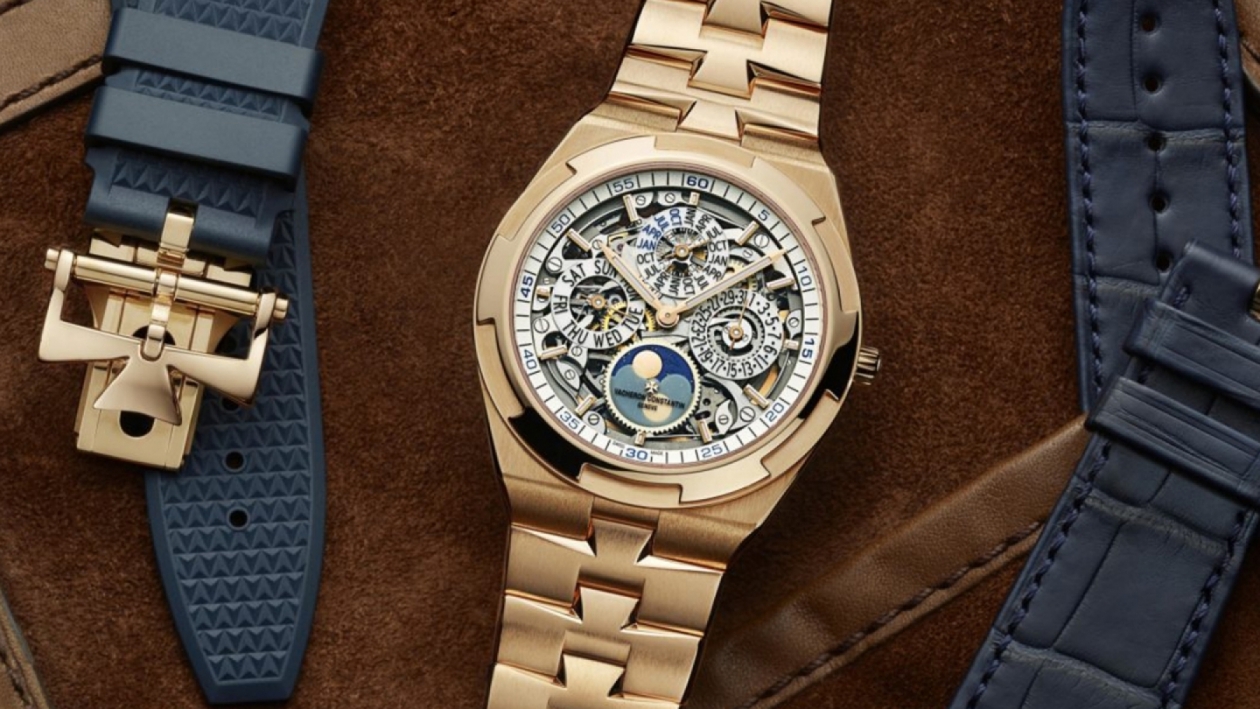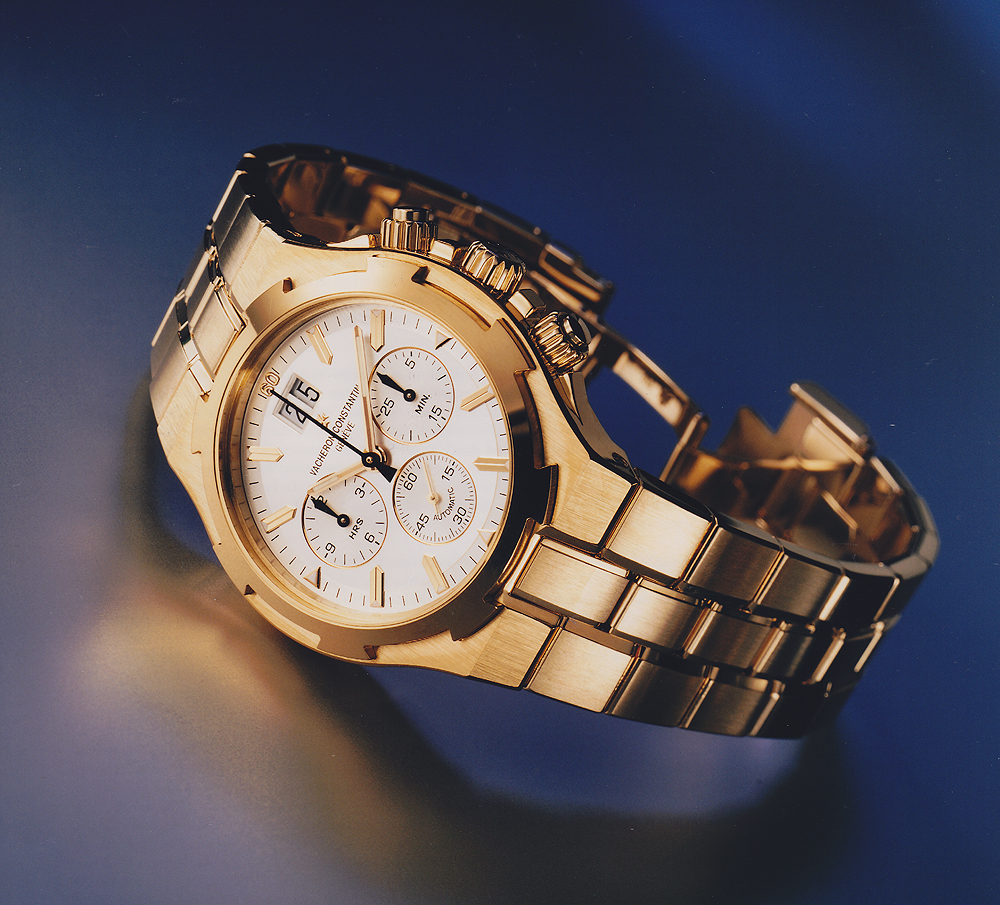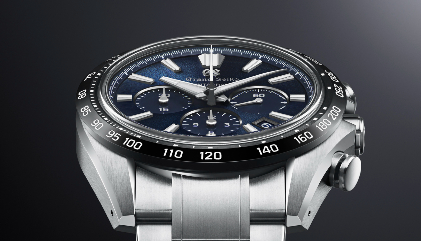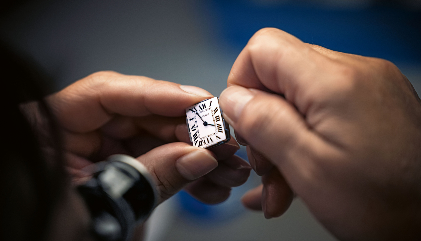The mid-1970s are widely regarded as a regrettable era for fashion, but one fashion accessory, the wristwatch, was having what is now acknowledged as a renaissance. More to the point, it was in the Seventies that the style we generally refer to as sport-luxury was established. Foundation pieces like the Audemars Piguet Royal Oak, in 1972, and the Patek Philippe Nautilus, in 1976, set the stage for many to follow, bridging the divide between classical elegance and masculine robustness. Few would have expected such bold departures from heritage watch Maisons like Audemars and Patek at the time, and certainly even fewer would have envisioned the timepiece that Vacheron Constantin, a Swiss manufacture even older than they and just as dedicated to tradition, would unveil for its 222nd anniversary in 1977.
The simply named Vacheron Constantin 222 was notable, and at the time viewed as somewhat radical, for its monobloc steel case, integrated steel bracelet with hexagonal centre links, and scalloped, screw-down bezel, which evoked, but certainly did not duplicate, the emblematic octagonal bezels that defined the Royal Oak and Nautilus.
True to Vacheron’s historically understated proportions, the 222 was slender in its profile — 7.2 mm thick for a 37-mm diameter. It contained a similarly thin Swiss-made automatic movement, Vacheron’s Caliber 1121, based on the famed Caliber 920 from Jaeger-LeCoultre. Also found inside both the early Nautilus and Royal Oak, this movement is still counted among the thinnest self-winding calibers in the world. At 5 o’clock on the corner of the case was placed the seed from which a more enduring watch family would bloom, two decades hence — a small, inlaid Maltese cross, which Vacheron Constantin adopted as its brand icon way back in 1880, and which formed the aesthetic foundation of the modern Overseas collection.
The 222 is often described in shorthand as the direct inspiration for the Overseas, but according to Christian Selmoni, heritage director of Vacheron Constantin, the story is a bit more complicated than that. “The idea was really not to create an evident link between the Triple Two and the Overseas,” Selmoni says, using the in-house jargon for the 222 and describing the starting point for the modern col- lection. “It was more about finding a new way to express what can be both sport and elegance at Vacheron Constantin, and the Triple Two is a credible example. The common points between the two watches are the barrel-shaped case and what we call the flat-table bezel, but the bracelets and their incorporation have always been very different. We don’t really consider the Overseas an evolution of the 222.”
Because the 222 captured the Seventies sport-luxury zeitgeist in such a familiar manner, and hails from the same era, it was once widely believed to have been among the brainchildren of the prolific Gérald Genta, who designed both the Royal Oak and the Nautilus as well as another recognised pioneer of the genre, IWC’s 1976 revamp of the Ingenieur. In actuality, the creative force behind the 222 was Jörg Hysek, a Berlin-born former Rolex designer who, like Genta, would go on to establish his own eponymous watch brand years later, after plying his trade for marques as diverse as Breguet, Tiffany & Co., and Seiko.
Vacheron didn’t make that many pieces of the 222: only around 500 models in steel, and significantly fewer in gold and bi-material steel-and-gold. Its production was discontinued in 1985. Nevertheless, the company followed up the 222 in 1984 with a model called the 333, which retained the integrated bracelet but swapped out its predecessor’s tonneau case with an octagonal one. On the heels of that short- lived model came the Phidias, with a rounded case flowing into an integrated bracelet, which introduced complications like chronographs and GMTs into the series.
It was in 1996 — with the sleeping giant that was the luxury mechanical watch just beginning to stir after years of quartz-watch market dominance — that the first model called “Overseas” was launched. Vacheron Constantin was on its way to being acquired by the Vendôme Group (now known as Richemont) and one of the manufacture’s first major releases under the new ownership, a return to the newly energised sport-luxury market, was already underway. Spearheaded by Vacheron Constantin’s head of design Vincent Kaufmann, and another well-regarded gun-for-hire in the wristwatch design arena, Dino Modolo, the Overseas was envisioned as a return to a more “disruptive” style of sporty watch, according to Selmoni. “The Phidias had very much the look of a 1980s watch, in my opinion,” he says. “The idea for the Overseas One was to come back to a more sporty character — using steel was a must, but the watch had to be elegant, sophisticated, and refined as well as sporty. We were all very enthusiastic about the design, which integrated our Maltese Cross.”
The tonneau-shaped case of the first-generation men’s Overseas replicated the dimensions of the 222 at 37 mm (the trend for much larger timepieces was still over the horizon), but in this model the notched bezel of the 1970s watch — somewhat reminiscent of a knob or a bottle cap — was replaced by a more distinctive, eight-sided type that replicated the arrowhead-shaped quadrilaterals of the Maltese cross. Inside the case, Vacheron installed a self-winding movement it dubbed Caliber 1310, which used a Girard-Perregaux 3100 caliber as its base. Vacheron Constantin added a chronograph version of the Overseas in 1999, powered by Caliber 1137, based on the column-wheel chronograph-equipped Frédéric Piguet Caliber 1185.
With its new, immediately recognisable bezel, the Overseas had begun to break away from the design language of both the 222, which was its closest aesthetic ancestor, and the classic 1970s Genta watches to which it had always been compared. But something was still missing. Once again, Vacheron’s venerable icon, the Maltese cross, would provide the key to the next evolution.
The renaissance of the hyper-masculine sport-luxury watch was in full swing by 2004, when Vacheron Constantin unveiled the Overseas “Phase 2” edition, which debuted in a three-hand model and a chronograph with large date. In keeping with market trends in the early-to-mid-aughts, its case was bulked up, to 42 mm, and a decorative, textured pattern was added to the dials. Vacheron did away with the crown guards of the Phase 1 series, making for a more stream- lined look. The all-important Maltese-cross-themed bezel was still present — the theme was also recognisable in the dial’s pattern — but what really separated the Phase 2 model was the use of the same visual motif for an updated and much more distinctive bracelet; the bracelet’s links were now shaped like half-Maltese crosses, and the center link now extended up to the bezel for a more seamless integration into the case. Even the buckle and the crown were updated to visually evoke the ancient symbol. On the technical side, Vacheron added a soft-iron inner cage inside the case for a greater degree of antimagnetic protection. “It was an era of bigger, more assertive watches,” Selmoni recalls, “and in our internal discussions, we realised that the bracelet was the element that really needed an update to give the watch that power and assertiveness. In the final design, we used the Maltese cross almost everywhere, along with making the watch larger.”
In 2006, and in keeping with the era’s craze for more complications as well as more girth in its watches, came the first Overseas Dual Time model — at some point, someone realised that a watch called “Overseas” needed a function for world travellers — powered by Caliber VC1222, based on the Jaeger-LeCoultre 920. The first Overseas on an integrated rubber strap, rather than the traditional bracelet, followed a year later, and a slew of increasingly complicated time- pieces in the collection swiftly followed, including a perpetual calendar chronograph.
In its Phase 2 iteration, the Overseas had firmly earned its spot in the upper echelon of easily recognisable sport-luxury timepieces with 1970s roots. The only element that hadn’t yet been added was the one for which Vacheron Constantin had become known in the 21st century: an honest- to-gosh manufacture movement, rather then one based on an outsourced caliber from one of its high-horology peers like Jaeger-LeCoultre or Girard-Perregaux. That finally changed in 2016, with the most recent revamp of the Overseas.
Overseas Phase 3, under the creative direction of Kaufmann, brought the watch’s overall dimensions back to a slightly more restrained level — 41 mm, down from 42 mm, for the basic three-hand “Self-Winding” model, and a relatively svelte 11 mm tall. The Maltese cross bezel — which coincidentally or not, based on the collection’s nautical name, had come to resemble a ship’s steering wheel — was scaled down from eight “spokes” to six. (Perhaps losing the octagonal aesthetic was the last word in separating the Overseas from its longtime peers, the Royal Oak and Nautilus.) More significantly, Vacheron Constantin finally installed its own in-house calibers in its Overseas watches, three of which were developed specially for the collection: the base Caliber 5100, powering the three-hand models in place of the JLC-based movement; the column-wheel-equipped 5200, replacing the Frédéric Piguet movement inside the 42.5-mm chronograph models; and the 5300, a smaller movement developed for the modern Overseas ladies’ or “Small” models — which, at 37 mm in diameter, returned at least part of the series to its modestly sized roots.
Comparing the Phase 2 to the Phase 3 Overseas, Selmoni is matter-of-fact. “We lost a bit of the elegance of the original Overseas,” he says of the former, “but you have to look at in the context of the 2000s. It was a great success but it was very much rooted in that era, and missing the refine- ments that you might find on a Patrimony, for example. We wanted to incorporate more sophistication and elegance in the next generation. We wanted to add a little touch of ‘vintage’ to the design, which meant going a bit more toward the Triple Two. And we wanted to bring the design back in-house. It was really a team effort, and it was really the most difficult generation of Overseas to design.”
In Phase 3, Vacheron didn’t wait several years to trot out all the most complicated models. Debuting alongside the three-hand, chronograph, and high-jewellery ladies’ editions at SIHH 2016 was the Overseas Perpetual Calendar Ultra Thin, outfitted with Vacheron’s wafer-like manufacture Caliber 1120 QP, a movement that had already wowed the watch community inside the elegant Patrimony collection. All of the calibers used in the Overseas Phase 3 models bore a new element tying them indelibly to the collection — a sold gold rotor emblazoned with a wind rose, a historical nautical device found on a compass. All of them also earn the prestigious poinçon de Genève, or Geneva Hallmark — a distinction in which Vacheron’s watchmakers have long taken pride.
Vacheron, of course, was eager to put these new, attractive calibers on display behind exhibition casebacks, as per modern custom. However, it also wanted to continue protecting them from the ill effects of magnetism inside a soft iron inner cage, as in the previous models. Kaufmann and his team hit upon a clever solution: instead of the typical design of such a cage, in which the shell covers the back of the movement, this one is positioned just inside a casing ring that is steeply angled toward the back, protecting the movement without covering it entirely.
The final and most contemporary addition in Phase 3, and another feature entirely new to the über-traditional Vacheron, was the addition of an “easy-fit” interchangeable strap and bracelet system, which allows wearers to change between bracelet and strap options without the need for a tool, simply by twisting the bracelet via the lugs by 180 degrees.
The revamped Overseas collection quickly began to grow in the wake of its celebrated debut in Geneva. Later that same year, Vacheron added a World Time model to the family, slightly bigger at 43.5 mm, equipping it with the ultra-sophisticated Caliber 2460WT, which famously debuted in a Patrimony model in 2011. Vacheron is justly proud of this movement, one of the few in the horological universe that can display all 37 world time zones rather than the standard 24 based on Greenwich Mean Time. In 2019, the Overseas Tourbillon debuted, impressing watch aficionados with its ultra-thin profile (thanks to its use of a peripheral rotor in the movement, Caliber 2160), its 80-hour power reserve, and its gorgeous blue dial, which Selmoni says uses a secret sauce of electroplating, varnish and lacquer to achieve its vibrancy.
The Overseas Dual Time, a practical complication that joined the collection in Phase 2, made its return, now also boasting a manufacture movement, Vacheron’s Caliber 5110 DT, derived from the base 5110 movement. Its signature function is the simultaneous reading of two time zones on co-axial hands: the main hour hand indicates local time in the wearer’s current location, while the triangular-tipped GMT hand points to the reference time on the 12-hour scale, which is linked to the day-night (“AM/PM”) indicator at 9 o’clock, allowing a traveller wearing the watch to determine at a glance if it’s daytime or nighttime back home.
More recently, as part of the digital-platformed Watches & Wonders 2020 exhibition that stood in for the planned, pandemic-scuttled live event in Geneva, Vacheron Constantin revisited its most high-complication Overseas model, the Perpetual Calendar, in two distinct executions, both in rose-gold cases. One version features the lacquered blue dial that has become a mainstay of the collection; the other model is the first Overseas with a skeletonised dial. For the latter, Vacheron Constantin meticulously stripped down the self-winding Caliber 1120 QP/1 to its essentials and replaced the solid gold wind-rose rotor with a black NAC-treated oscillating mass that incorporates the ubiquitous Maltese cross shape. Through the sapphire dial, with four white disks displaying the calendar indications in a classical cloverleaf design, one can glimpse the ornate engravings, straight- grained and beveled edges, circular brushing, sunburst finishing, and other elements that elevate the timepiece from its sport-watch basics to the highest levels of haute horlogerie. Like the rest of the collection, it is offered with three quick- change bracelets — one in rose gold, one in blue alligator leather, one in textured blue rubber.
It is perhaps inevitable that the Vacheron Contantin Overseas will always be grouped among, and compared and contrasted with, the other iconic 1970s sport-luxury timepieces — despite the fact that the Overseas is actually several decades younger. What sets it apart, however, is the fact that while its design origins are traced to the same era, the Overseas has evolved more profoundly than any of its peers, representing for a growing contemporary audience an ideal amalgam of vintage and modern appeal.




























